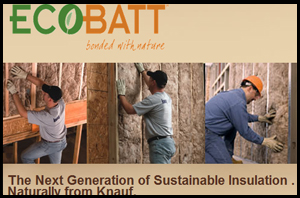
“Knauf EcoBatt™ Insulation doesn’t look like any insulation you’ve ever seen, but that’s because its natural brown color represents a level of sustainability never before achieved.
The color comes from ECOSE™ Technology, a revolutionary, new sustainable binder born from five years of intensive research. Made from rapidly renewable organic materials rather than petroleum-based chemicals commonly used in other insulation products, ECOSE Technology reduces binder embodied energy by up to 70%, and does not contain phenol, formaldehyde, acrylics or artificial colors used to make traditional fiberglass insulation.
EcoBatt Insulation combines sand, one of the world’s most abundant and renewable resources, post-consumer recycled bottle glass and ECOSE Technology to create the next generation of sustainable insulation…naturally from Knauf.
Features & Benefits
Sustainable
• Made primarily from sand, one of the world’s most abundant and renewable resources
• Lower embodied energy than our traditional batts
• Rapidly renewable binder eliminates petroleum-based chemicals
• Contains no phenol, formaldehyde, acrylics or artificial colors
High Recycled Content
• Contains a minimum of 61.9% post-consumer recycled content
Thermally Efficient
• Excellent insulating value
Acoustical Performance
• Reduces airborne sound transmission
• Significantly improves STC ratings of wall configurations
Legendary Handling
• Cuts easily and cleanly
• Recovers quickly
• Less dusty
• Friendly feel
• Does not support microbial growth or attract insects or vermin.
• Noncombustible (Unfaced)”

the R value is on the packaging. We have R-19.
It’s still a low grade of insulation.
For starters, they don’t want you to know the R-Factor for their insulation product. They have a website promoting it’s “green” properties, but they don’t show how good it is at the most important factor? The greenest thing you can do to a building is make the building itself extremely energy efficient, and insulation is probably the most important way to help accomplish this goal.
Why are they so ashamed of the R-Factor? Why are they not advertising the single most important specification of their product?
Not one reference anywhere on their website offers this data.
I suggest that is because their product is a crappy insulator.
This is the case for ALL fiberglass products. Fiberglass is the worst class of insulations used in construction. Fiberglass puts the “minimum” in “minimum code.” In fact, the code minimums were written specifically to downgrade the minimum acceptable performance standards so that crappy fiberglass products could be used between wall studs.
Fiberglass can ONLY be effective (such as it is) if used with air and vapor sealing products, which detracts from the “green” of the whole insulating system.
If someone wants to build a green building, start by designing a structure that will use a minimum of energy over the building’s lifespan, not just during the product manufacturing phase. Using a crappy insulator because it has some special “green” glue inside it is foolish.
The smart builder will use the best insulation that the project budget will allow. Not a product that makes sketchy claims like this one.
Personally, I suggest strawbale. It’s far superior in every way. Better insulator. No toxicity. Easier to use thicker walls to get high R-Factors.
Good grief, even something as toxic as sprayfoam (there are lower toxicity versions) would be better than Ecobatt over the long term, because it performs the job of insulating so much better, and also seals air gaps. The eco-payoff over the long term would dwarf the tiny eco-benefit of a fancy glue used in Ecobatts. Not that I recommend this product either, except sometimes in miniscule quantities to seal difficult gaps around doors, windows, and such.
A couple of drops of greenish glue on a crappy product doesn’t magically make it green.
Yeah, not listing the R-value on their website is highly suspicious. It must be pretty low. I was suspicious of the photos of workers not wearing masks, which gives the misleading impression masks aren’t necessary. Maybe there’s less dust than regular fiberglass insulation, but almost certainly there will be quite a bit of dust and it would be foolish not to wear a mask.
How is this different from mineral wool?
I don’t know all the details. They claim it’s made with natural materials. That’s good. But there will still be some health risk with handling fiber batt insulation. Fibers tend to break off into tiny pieces that go everywhere. You’d want to check if these fibers create hazardous dust and itching. Always wear a mask and gloves just in case.